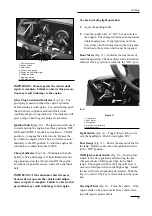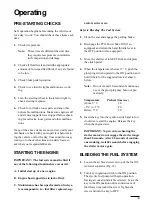
Safety
13. Since gasoline is highly flammable, handle it
carefully.
A. Use an approved gasoline container.
B. Do not remove cap from fuel tank when
engine is hot or running.
C. Do not smoke while handling gasoline.
D. Fill fuel tank outdoors and to about one inch
below top of tank (bottom of filler neck). Do
not overfill.
E. Wipe up any spilled gasoline.
14. Check the safety interlock system daily for prop-
er operation. If a switch should malfunction,
replace the switch before operating machine.
After every two years, replace the interlock
switches in the safety system, whether they are
working properly or not.
WHILE OPERATING
WARNING: Engine exhaust contains carbon
monoxide which is an odorless, deadly poison.
Carbon monoxide is also known to the State
of California to cause birth defects. Do not
run engine indoors or in an enclosed area.
15. Operator and passenger should remain seated
whenever the vehicle is in motion. Operator
should keep both hands on steering wheel, when-
ever possible and passenger should use the hand
holds provided. Keep arms and legs within the
vehicle body at all times. Never carry passengers
in box or on attachments. Remember your pas-
senger may not be expecting you to brake or turn
and may not be ready.
16. Never overload your vehicle. Name plate (locat-
ed under dash on passenger side) shows load
limits for vehicle. Never overfill attachments or
exceed the vehicle maximum gross vehicle
weight.
17. When starting the engine:
A. Sit on operator’s seat and engage the parking
brake.
B. Disengage PTO (if so equipped) and return
the hand throttle lever to OFF position (if so
equipped).
C. Move shift lever to NEUTRAL and depress
clutch pedal.
D. Keep foot off the accelerator pedal.
E. Diesel models only: Turn ignition key to
ON, hold glow switch ON (maximum 30
seconds.)
F. Turn ignition key to START.
18. Using the machine demands attention. Failure to
operate vehicle safely may result in a accident,
tip over of vehicle and serious injury or death.
Drive carefully. To prevent tipping or loss of
control:
A. Use extreme caution, reduce speed and
maintain a safe distance around sand traps,
ditches, creeks, ramps, any unfamiliar areas
or other hazards.
B. Watch for holes or other hidden hazards.
C. Use caution when operating vehicle on a
steep slope. Normally travel straight up and
down slopes. Reduce speed when making
sharp turns or when turning on hillsides.
Avoid turning on hillsides whenever possi-
ble.
D. Use extra caution when operating vehicle on
wet surfaces, at higher speeds or with a full
load. Stopping time will increase with a full
load. Shift into a lower gear before starting
up or down a hill.
E. When loading bed, distribute load evenly.
Use extra caution if the load exceeds the
dimensions of the vehicle/bed. Operate vehi-
cle with extra caution when handling off-
center loads that cannot be centered. Keep
loads balanced and secure to prevent them
from shifting.
4



































